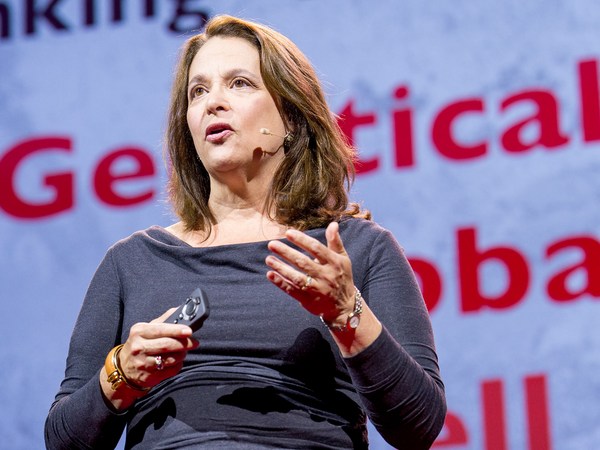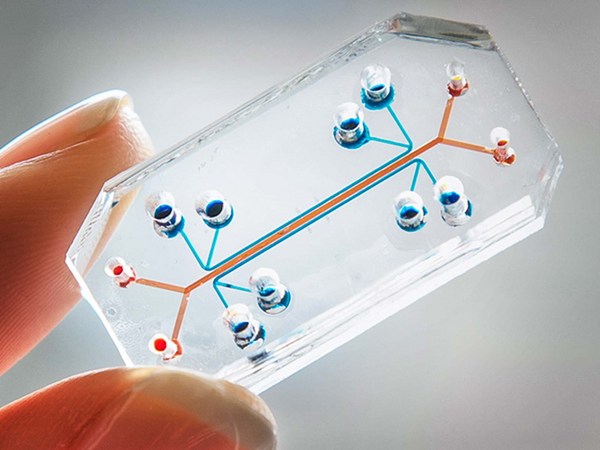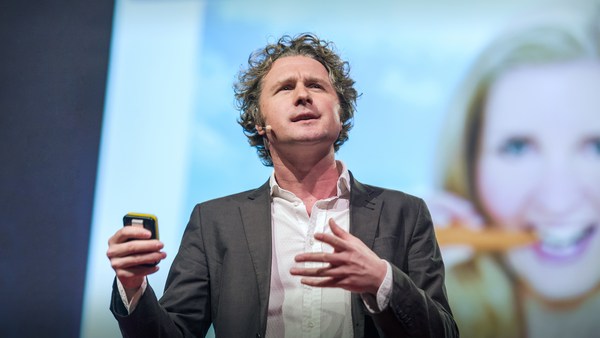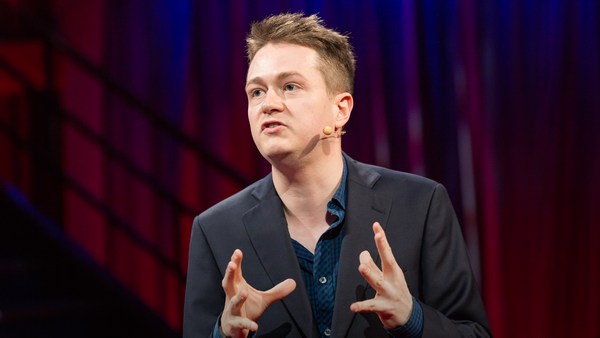So this is a picture of my dad and me, at the beach in Far Rockaway, or actually Rockaway Park. I'm the one with the blond hair. My dad's the guy with the cigarette. It was the 60's. A lot of people smoked back then. In the summer of 2009, my dad was diagnosed with lung cancer. Cancer is one of those things that actually touches everybody. If you're a man in the US, you've got about a one in two chance of being diagnosed with cancer during your lifetime. If you're a woman, you've got about a one in three chance of being diagnosed with cancer. Everybody knows somebody who's been diagnosed with cancer.
Now, my dad's doing better today, and part of the reason for that is that he was able to participate in the trial of an experimental new drug that happened to be specially formulated and very good for his particular kind of cancer. There are over 200 kinds of cancer. And what I want to talk about today is how we can help more people like my dad, because we have to change the way we think about raising money to fund cancer research.
So a while after my dad was diagnosed, I was having coffee with my friend Andrew Lo. He's the head of the Laboratory for Financial Engineering at MIT, where I also have a position, and we were talking about cancer. And Andrew had been doing his own bits of research, and one of the things that he had been told and that he'd learned from studying the literature was that there's actually a big bottleneck. It's very difficult to develop new drugs, and the reason it's difficult to develop new drugs is because in the early stages of drug development, the drugs are very risky, and they're very expensive. So Andrew asked me if I'd want to maybe work with him a bit, work on some of the math and the analytics and see if we could figure out something we could do.
Now I'm not a scientist. You know, I don't know how to build a drug. And none of my coauthors, Andrew Lo or Jose-Maria Fernandez or David Fagnan -- none of those guys are scientists either. We don't know the first thing about how to make a cancer drug. But we know a little bit about risk mitigation and a little bit about financial engineering, and so we started thinking, what could we do? I'm going to tell you about some work we've been doing over the last couple years that we think could fundamentally change the way research for cancer and lots of other things gets done. We want to let the research drive the funding, not the other way around.
So in order to get started, let me tell you how you get a drug financed. Imagine that you're in your lab -- you're a scientist, you're not like me -- and you've developed a new compound that you think might be therapeutic for somebody with cancer. Well, what you do is, you test in animals, you test in test tubes, but there's this notion of going from the bench to the bedside, and in order to get from the bench, the lab, to the bedside, to the patients, you've got to get the drug tested. And the way the drug gets tested is through a series of, basically, experiments, through these large, they're called trials, that they do to determine whether the drug is safe and whether it works and all these things. So the FDA has a very specific protocol. In the first phase of this testing, which is called testing for toxicity, it's called Phase I. In the first phase, you give the drug to healthy people and you see if it actually makes them sick. In other words, are the side effects just so severe that no matter how much good it does, it's not going to be worth it? Does it cause heart attacks, kill people, liver failure? And it turns out, that's a pretty high hurdle. About a third of all drugs drop out at that point. In the next phase, you test to see if the drug's effective, and you give it to people with cancer and you see if it makes them better. And that's also a higher hurdle. People drop out. And in the third phase, you test it on a very large sample, and you're trying to determine what the right dose is, is it better than what's available today? If not, then why build it? When you're done with all that, what you have is a very small percentage of drugs that start the process actually come out the other side. So those blue bottles -- those blue bottles save lives, and they're also worth billions, sometimes billions a year.
So now here's a question: if I were to ask you, for example, to make a one-time investment of, say, 200 million dollars to buy one of those bottles, so 200 million dollars up front, one time, to buy one of those bottles, I won't tell you which one it is, and in 10 years, I'll tell you whether you have one of the blue ones. Does that sound like a good deal for anybody? No. No, right? And of course, it's a very, very risky trial position, and that's why it's very hard to get funding, but to a first approximation, that's actually the proposal. You have to fund these things from the early stages on. It takes a long time.
So Andrew said to me, he said, "What if we stop thinking about these as drugs? What if we start thinking about them as financial assets?" They've got really weird payoff structures and all that, but let's throw everything we know about financial engineering at them. Let's see if we can use all the tricks of the trade to figure out how to make these drugs work as financial assets.
Let's create a giant fund. In finance, we know what to do with assets that are risky. You put them in a portfolio and you try to smooth out the returns. So we did some math, and it turned out you could make this work, but in order to make it work, you need about 80 to 150 drugs.
Now the good news is, there's plenty of drugs that are waiting to be tested. We've been told that there's a backlog of about 20 years of drugs that are waiting to be tested but can't be funded. In fact, that early stage of the funding process, that Phase I and preclinical stuff, that's actually, in the industry, called the Valley of Death because it's where drugs go to die. It's very hard to for them to get through there, and of course, if you can't get through there, you can't get to the later stages.
So we did this math, and we figured out, OK, well, you need about 80 to, say, 150, or something like that, drugs. And then we did a little more math, and we said, OK, well, that's a fund of about three to 15 billion dollars. So we kind of created a new problem by solving the old one. We got rid of the risk, but now we need a lot of capital, and you can only get that kind of capital in the capital markets. Venture capitalists and philanthropies don't have it. But we have to figure out how to get people in the capital markets, who traditionally don't invest in this, to want to invest in this stuff. So again, financial engineering was helpful here. Imagine the megafund starts empty, and what it does is it issues some debt and some equity, and that generates cash flow. That cash flow is used, then, to buy that big portfolio of drugs that you need, and those drugs start working their way through that approval process, and each time they go through a phase of approval, they gain value. Most of them don't make it, but a few of them do, and with the ones that gain value, you can sell some, and when you sell them, you have money to pay the interest on those bonds, but also to fund the next round of trials. It's almost self-funding. You do that for the course of the transaction, and when you're done, you liquidate the portfolio, pay back the bonds, and you can give the equity holders a nice return.
That was the theory, and we talked about it, we did a bunch of experiments, and then we said, let's really try to test it. We spent the next two years doing research. We talked to hundreds of experts in drug financing and venture capital. We talked to people who have developed drugs. We talked to pharmaceutical companies. We actually looked at the data for drugs, over 2,000 drugs that had been approved or denied or withdrawn, and we also ran millions of simulations. And all that actually took a lot of time. But when we were done, we found something that was sort of surprising. It was feasible to structure that fund such that when you were done structuring it, you could actually produce low-risk bonds that would be attractive to bond holders, that would give you yields of about five to eight percent, and you could produce equity that would give equity holders about a 12 percent return. Now those returns aren't going to be attractive to a venture capitalist. They want to make those big bets and get those billion dollar payoffs. But it turns out there are lots of other folks that would be interested. That's right in the investment sweet spot of pension funds and 401(k) plans and all this other stuff.
So we published some articles in the academic press, in medical journals, in finance journals. But it wasn't until we actually got the popular press interested in this that we began to get some traction.
We wanted to do more than just make people aware of it. We wanted people to get involved. So we took all of our computer code and made that available online under an open-source license to anybody that wanted it. And you guys can download it today if you want to run your own experiments to see if this would work. And that was really effective, because people that didn't believe our assumptions could try their own and see how it would work.
Now there's an obvious problem, which is, is there enough money in the world to fund this? I've told you there's enough drugs, but is there enough money? There's 100 trillion dollars of capital currently invested in fixed-income securities. That's a hundred thousand billion. There's plenty of money.
(Laughter)
But we realized it's more than just money that's required. We had to get people motivated, involved, and get them to understand this. And we started thinking about all the different things that could go wrong. What are all the challenges that might get in the way? And we had a long list. We assigned a bunch of people, including ourselves, different pieces of this problem. And we said, could you start a work stream on credit risk? Could you start a work stream on the regulatory aspects? Could you start a work stream on how you would manage so many projects? And we had all these experts get together and do these different work streams, and then we held a conference. The conference was held over this past summer. It was an invitation-only conference. It was sponsored by the American Cancer Society and done in collaboration with the National Cancer Institute. We had experts from every field we thought would be important, including the government, and people that run research centers, and for two days they heard the reports from those five work streams, and talked about it. It was the first time the people who could make this happen sat across the table from each other and had these conversations.
Now these conferences, it's typical to have a dinner, and at that dinner, you get to know each other, sort of like what we're doing here. I happened to look out the window, and hand on my heart, on the night of this conference -- it was the summertime -- and that's what I saw, a double rainbow. So I'd like to think it was a good sign.
Since the conference, we've got people working between Paris and San Francisco, lots of different folks working on this to try to see if we can really make it happen. We're not looking to start a fund, but we want somebody else to do this. Because, again, I'm not a scientist. I can't build a drug. I'm never going to have enough money to fund even one of those trials. But all of us together, with our 401(k)s, with our 529 plans, with our pension plans, all of us together can actually fund hundreds of trials and get paid well for doing it and save millions of lives like my dad.
Thank you.
(Applause)





